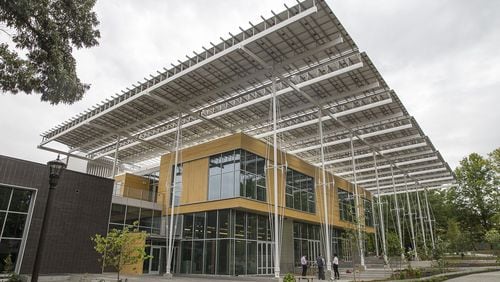Several Georgia universities are taking the lead in moving their campuses to a 100% clean energy future, according to a new report from Environment Georgia, an organization that uncovers environmental challenges and advocates for solutions.
>> RELATED: Green school buildings put metro Atlanta in design spotlight
The report, released Tuesday, features case studies of Georgia colleges that have made significant efforts to achieve their energy goals. It was designed to serve as a guide to help other schools achieve similar goals, said Jennette Gayer, executive director of Environment Georgia.
“We see that each of these case studies is a glimpse into the possibilities of a clean energy future,” said Gayer. “Starting with these bold but simple steps is a way to get … to 100% clean energy.”
As more cities follow Atlanta, Augusta, Athens and Clarkston in adopting 100% clean energy goals -- meaning all energy is from carbon-free sources-- Georgia universities have also invested in a range of solutions to address environmental issues from installing more efficient heating and cooling systems to supporting greener transportation options on campus. The innovations have also provided opportunities for student learning and advanced research.
The report first recognizes the Kendeda Building at Georgia Institute of Technology as the single building that best exemplifies a commitment to clean energy. Built to the ambitious standards of the Living Building Challenge 3.1, the Kendeda Building features an overall design that lowers energy demand by using the sun's position and an energy-efficient cooling and heating system in the floor. The building is designed to generate more energy and water than it uses each year.
Campus buildings account for the majority of energy used by universities, and energy-efficient measures are the cheapest way to meet many energy needs. Spelman College and the University of Georgia installed LED lighting to reduce costs. Augusta University’s Dental College of Georgia is the campus’ only LEED Silver certified building featuring a roof that reflects sun’s heat while restrooms and dental equipment reduce water use by 40%.
Emory University and Albany State University got high marks for energy conservation efforts. Emory has pledged to reduce energy and water consumption by 20% by 2020. In a single year, Albany State reduced energy usage by 43%, the largest reduction in the University System of Georgia from 2016-17.
Ogeechee Technical College, Georgia Tech and the University of Georgia have invested in solar arrays, including solar picnic table charging stations that enable students at the UGA’s main campus in Athens to charge their devices.
Georgia Tech, in partnership with Georgia Power, has also installed a microgrid, which allows for energy storage from a range of clean sources and which can deliver power to nearby buildings.
Transportation has surpassed electricity generation as the leading source of greenhouse gas emissions in the U.S., according to data from the Environmental Protection Agency.
Credit: David Wickert
Credit: David Wickert
This year, UGA will replace more than 30 diesel buses with Proterra electric buses, creating one of the largest electric bus fleets in the U.S. Emory University and Georgia State University were recognized for efforts in encouraging sustainable transportation, including biking, walking paths, shuttles and charging stations for electric vehicles.
Some universities are taking advantage of renewable energy purchasing. Fort Valley State is leasing 107 acres on campus to Georgia Power to build a solar field while Agnes Scott College has five solar arrays on campus from which it earns credits that offset 150 metric tons of carbon emissions each year.
Agnes Scott was also recognized for having two buildings with geothermal systems, which draw energy from the earth for heating and cooling. Residual heat is used to heat hot water in the building, while Georgia State uses a solar thermal system to heat water in one of its library locations on the main campus downtown.
Most schools offer some form of recycling, but Georgia Southern University uses a series of creative competitions such as a Recycled Boat Regatta competition to engage students in the efforts. Georgia State is one of three universities in the country to own and operate a polystyrene (aka Styrofoam) densifier to shred, crush and melt industrial-grade material to a fraction of its original size.
About the Author









